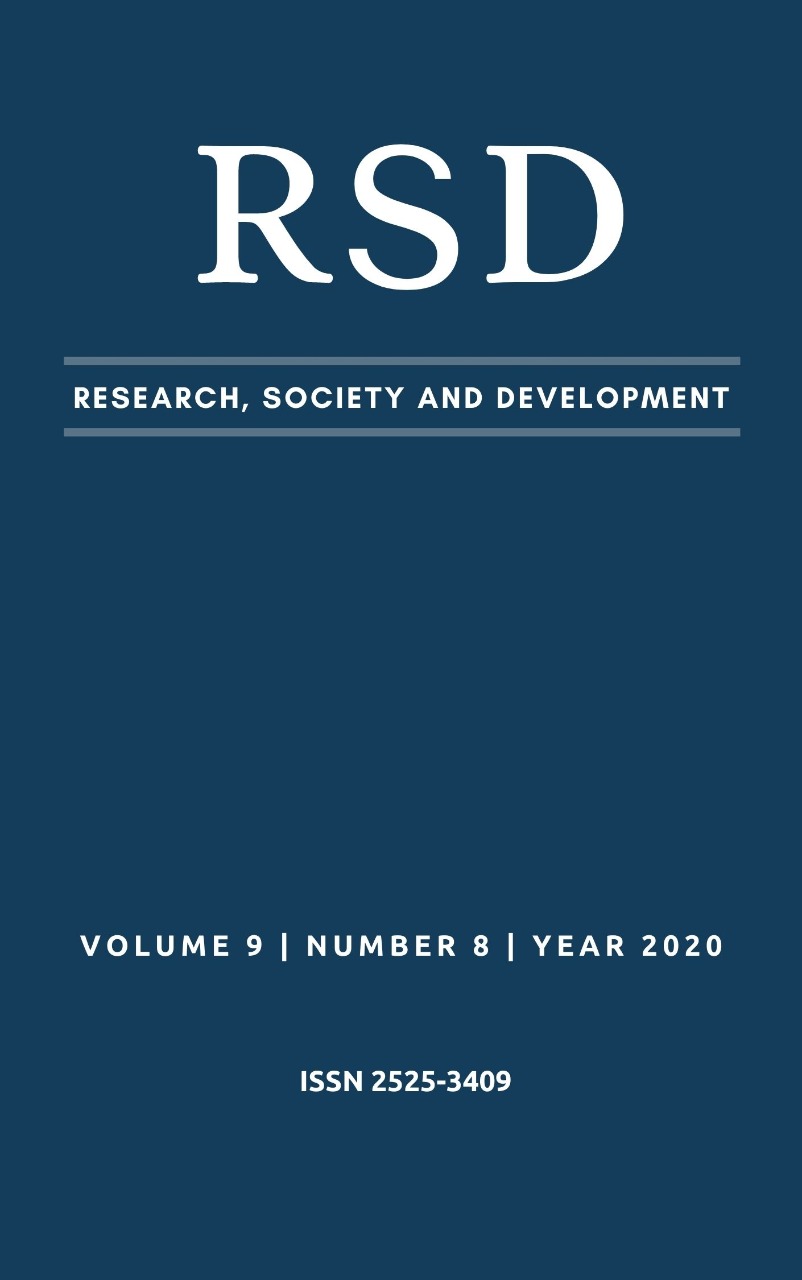Análise de agrupamentos exploratória dos usuários do Programa Multidisciplinar de Tratamento do Tabagismo do HUAC, Campina Grande – PB
DOI:
https://doi.org/10.33448/rsd-v9i8.6532Palavras-chave:
Tabagismo, Promoção da saúde, agrupamento.Resumo
Considerando a relação entre os dados do consumo do tabagismo e as percepções das pessoas sobre os efeitos desse consumo, objetivou-se fornecer uma análise exploratória completa dos dados, utilizando técnicas de agrupamento, traçando perfis de participantes do Programa Multidisciplinar de tratamento do Tabagismo (PMTT). A partir das 117 variáveis de 714 usuários do PMTT produzidas do questionário de avaliação médica do paciente original, foram selecionadas 32 variáveis relevantes. Foram filtrados 495 usuários que continham informações nas 32 variáveis selecionadas, sendo 5 variáveis quantitativas, 22 qualitativas nominais e 5 qualitativas ordinais. Para estes participantes, foi empregada análise de agrupamentos. O menor entrelaçamento médio foi utilizado para escolher a medida de dissimilaridade empregada conjuntamente com o método de Ward. Foram identificados três grupos distintos de tabagistas. Os resultados da análise agrupamento confirmam a presença de três grupos distintos de usuários do PMTT. Em acréscimo, o estudo indicou haver padrões diferenciados entre variáveis sexo, religião, renda e histórico de enfermidades, além de diferenças de perfis tabagistas. O trabalho apresenta considerações sobre a responsabilidade das pessoas na prevenção e redução das taxas de consumo entre a sua população. Os resultados obtidos traçam perfis de fumantes que possuem consideráveis tempos de tabagismo e altos consumos diários de cigarros. Tais perfis ressaltam a importância de políticas públicas abrangentes e articuladas, de preferência preventivas, apostando na educação e promoção da saúde ou no incremento da qualidade de vida.
Referências
Albuquerque, M. A., & Barros, K. N. N. O. (2020). Introdução à Análise de Agrupamento: teoria e prática com aplicações em R. [e-book]. Campina Grande. Ed. EDUEPB. Disponível em: http://eduepb.uepb.edu.br/download/introducao-a-analise-de-agrupamento-teoria-e-pratica-com-aplicacoes-em-r/?wpdmdl=997&masterkey=5e97904980fc9
Albuquerque, M. A., Barros, K. N. N. O., Gouveia, J. F., & Ferreira, R. L. C. (2016). Determination and validation of group numbers in a cluster analysis: A case study applied to forestry science. Acta Scientiarum. Technology, 38(3), 339-344.
Albuquerque, T. M., Araujo, G. A. B., Caminha, B. L., Albuquerque, M. L., & Albuquerque, M. A. (2016). Measures of association in epidemiological studies: smoking mothers and low birth weight children in the city of Campina Grande–PB. Acta Scientiarum. Health Sciences, 38(2), 179-84.
Bush, T., Lovejoy, J. C., Deprey, M., & Carpenter, K. M. (2016). The effect of tobacco cessation on weight gain, obesity, and diabetes risk. Obesity, 24(9), 1834-41.
Calsavara, T.V.S., & Fontanella, B.J.B. (2007). Uso de tabaco iniciado na infância: relatos de adultos em tratamento. Jornal Brasileiro de Psiquiatria, 56(4), 252-9.
Caram, L. M. D. O., Ferrari, R., Tanni, S. E., Coelho, L. S., Godoy, I. D., Martin, R. D. S., & Godoy, I. D. (2009). Perfil de fumantes atendidos em serviço público para tratamento do tabagismo. Jornal Brasileiro de Pneumologia, 35(10), 980-5.
Cormack, R. M. (1971). A review of classification. Journal of the Royal Statistical Society: Series A (General), 134(3), 321-53.
Cornish, R. (2007). Statistics: cluster analysis. Mathematics Learning Support Centre, 1-5.
El-Hamdouchi, A., & Willett, P. (1989). Comparison of hierarchic agglomerative clustering methods for document retrieval. The Computer Journal, 32(3), 220-7.
Gower, J. C., & Legendre, P. (1986). Metric and Euclidean properties of dissimilarity coefficients. Journal of classification, 3(1), 5-48.
Johnson, R. A., & Wichern, D. W. (2002). Applied multivariate statistical analysis (Vol. 5, No. 8). Upper Saddle River, NJ: Prentice hall.
Kaufman, L., & Rousseeuw, P. J. (2009). Finding groups in data: an introduction to cluster analysis (Vol. 344). John Wiley & Sons.
Otero, M. (2004). Tabaquismo en la mujer: consideraciones especiales. Trastornos adictivos, 6(2), 113-124.
Panaino, E. F., Soares, C. B., & Campos, C. M. S. (2014). Context of the beginning of tobacco use in different social groups. Revista Latino-Americana de Enfermagem, 22(3), 379-385.
Pereira, A. S., Shitsuka, D. M., Parreira, F. J., & Shitsuka, R. (2018). Metodologia da pesquisa científica. [e-book]. Santa Maria. Ed. UAB/NTE/UFSM. Disponível em: https://repositorio.ufsm.br/bitstream/handle/1/15824/Lic_Computacao_Metodologia-Pesquisa-Cientifica.pdf?sequence=1
R Core Team (2014). R: A language and environment for statistical computing. R Foundation for Statistical Computing. Viena, Austria. Disponível em: http://www.R-project.org/
Senger, A. E. V., Ely, L. S., Gandolfi, T., Schneider, R. H., Gomes, I., & Carli, G. A. (2011). Alcoolismo e tabagismo em idosos: relação com ingestão alimentar e aspectos socioeconômicos. Revista Brasileira de Geriatria e Gerontologia, 14(4), 713-719.
Downloads
Publicado
Edição
Seção
Licença
Copyright (c) 2020 Mácio Augusto Albuquerque, Klebe Napoleão N. Oliveira Barros, Amanda Santos Gomes, Deborah Rose Galvão Dantas

Este trabalho está licenciado sob uma licença Creative Commons Attribution 4.0 International License.
Autores que publicam nesta revista concordam com os seguintes termos:
1) Autores mantém os direitos autorais e concedem à revista o direito de primeira publicação, com o trabalho simultaneamente licenciado sob a Licença Creative Commons Attribution que permite o compartilhamento do trabalho com reconhecimento da autoria e publicação inicial nesta revista.
2) Autores têm autorização para assumir contratos adicionais separadamente, para distribuição não-exclusiva da versão do trabalho publicada nesta revista (ex.: publicar em repositório institucional ou como capítulo de livro), com reconhecimento de autoria e publicação inicial nesta revista.
3) Autores têm permissão e são estimulados a publicar e distribuir seu trabalho online (ex.: em repositórios institucionais ou na sua página pessoal) a qualquer ponto antes ou durante o processo editorial, já que isso pode gerar alterações produtivas, bem como aumentar o impacto e a citação do trabalho publicado.


